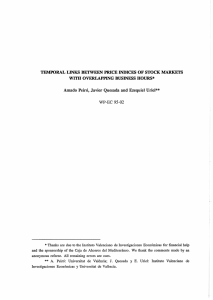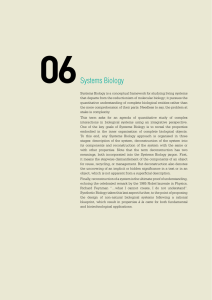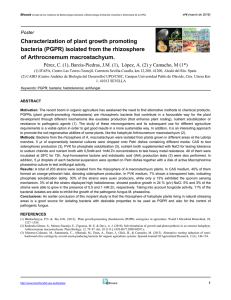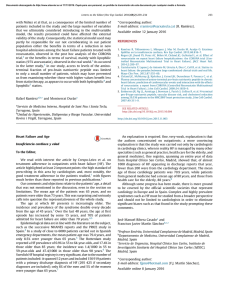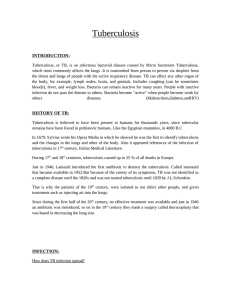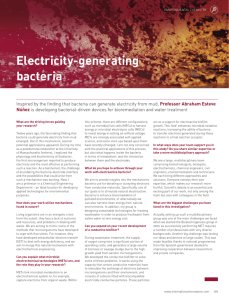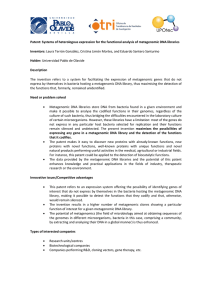Halomonas maura is a physiologically versatile bacterium of both
Anuncio
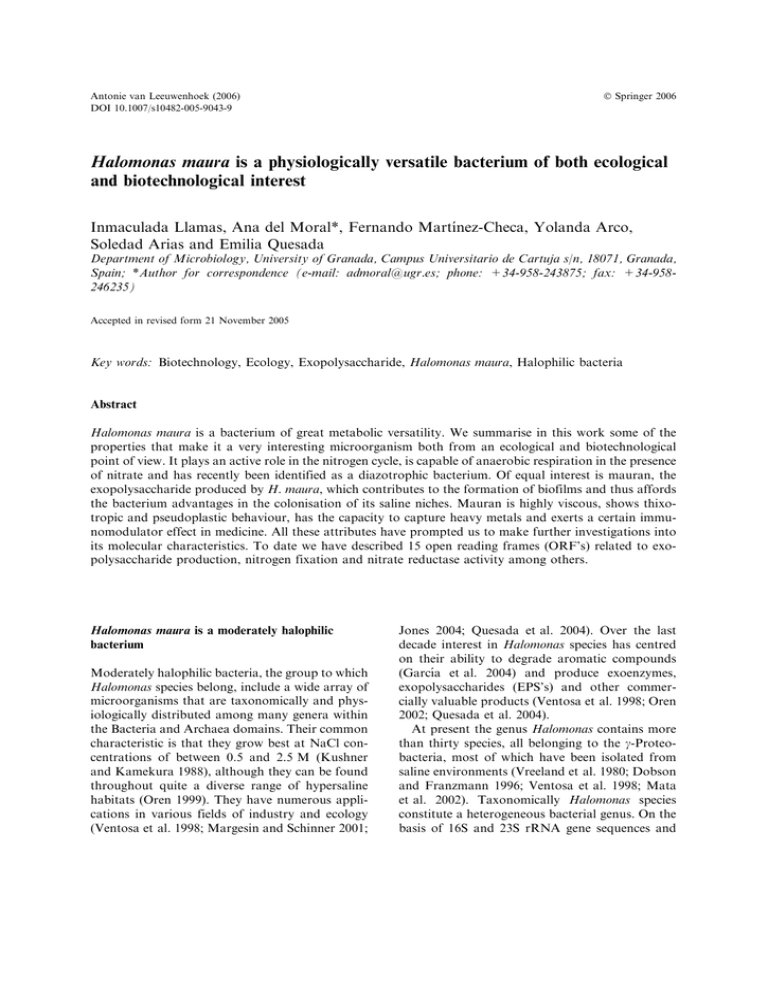
Antonie van Leeuwenhoek (2006) DOI 10.1007/s10482-005-9043-9 Ó Springer 2006 Halomonas maura is a physiologically versatile bacterium of both ecological and biotechnological interest Inmaculada Llamas, Ana del Moral*, Fernando Martı́nez-Checa, Yolanda Arco, Soledad Arias and Emilia Quesada Department of Microbiology, University of Granada, Campus Universitario de Cartuja s/n, 18071, Granada, Spain; *Author for correspondence (e-mail: admoral@ugr.es; phone: +34-958-243875; fax: +34-958246235) Accepted in revised form 21 November 2005 Key words: Biotechnology, Ecology, Exopolysaccharide, Halomonas maura, Halophilic bacteria Abstract Halomonas maura is a bacterium of great metabolic versatility. We summarise in this work some of the properties that make it a very interesting microorganism both from an ecological and biotechnological point of view. It plays an active role in the nitrogen cycle, is capable of anaerobic respiration in the presence of nitrate and has recently been identified as a diazotrophic bacterium. Of equal interest is mauran, the exopolysaccharide produced by H. maura, which contributes to the formation of biofilms and thus affords the bacterium advantages in the colonisation of its saline niches. Mauran is highly viscous, shows thixotropic and pseudoplastic behaviour, has the capacity to capture heavy metals and exerts a certain immunomodulator effect in medicine. All these attributes have prompted us to make further investigations into its molecular characteristics. To date we have described 15 open reading frames (ORF’s) related to exopolysaccharide production, nitrogen fixation and nitrate reductase activity among others. Halomonas maura is a moderately halophilic bacterium Moderately halophilic bacteria, the group to which Halomonas species belong, include a wide array of microorganisms that are taxonomically and physiologically distributed among many genera within the Bacteria and Archaea domains. Their common characteristic is that they grow best at NaCl concentrations of between 0.5 and 2.5 M (Kushner and Kamekura 1988), although they can be found throughout quite a diverse range of hypersaline habitats (Oren 1999). They have numerous applications in various fields of industry and ecology (Ventosa et al. 1998; Margesin and Schinner 2001; Jones 2004; Quesada et al. 2004). Over the last decade interest in Halomonas species has centred on their ability to degrade aromatic compounds (Garcı́a et al. 2004) and produce exoenzymes, exopolysaccharides (EPS’s) and other commercially valuable products (Ventosa et al. 1998; Oren 2002; Quesada et al. 2004). At present the genus Halomonas contains more than thirty species, all belonging to the c-Proteobacteria, most of which have been isolated from saline environments (Vreeland et al. 1980; Dobson and Franzmann 1996; Ventosa et al. 1998; Mata et al. 2002). Taxonomically Halomonas species constitute a heterogeneous bacterial genus. On the basis of 16S and 23S rRNA gene sequences and phenotypic studies, Arahal et al. (2002) have established various distinct phylogenetic groups (Mata et al. 2002). Some of the Halomonas species, including Halomonas eurihalina, Halomonas maura, Halomonas ventosae, Halomonas anticariensis and Halomonas almeriensis, which were isolated from the rhizosphere of xerophytic plants and characterised by our research group (Quesada et al. 1990; Bouchotroch et al. 2001; Martı́nezCánovas et al., 2004a; 2004b; Martı́nez-Checa et al. 2005), produce extracellular polysaccharides with potential biotechnological applications (Calvo et al. 2002; Béjar et al. 1998; Martı́nez-Checa et al. 2002; Arias et al. 2003; Quesada et al. 2004). Halomonas maura is a Gram-negative rod, occurring either singly or in pairs, or occasionally as long filaments. The cells are capsulated, nonmotile and accumulate PHA. They do not form endospores. They grow best in media containing 0.5 to 2.5 M NaCl, although their eurihaline character allows them to grow within a range of salt concentrations of between 1% and 15% w/v. They use the following compounds as sole carbon and energy sources: citrate, ethanol, fumarate, D-fructose, glycerol, D-rhamnose and D-ribose; they do not use lactose or D-trehalose (Bouchotroch et al. 2001). Natural habitat of Halomonas maura Species of the genus Halomonas are to be found growing both in hypersaline thalassal environments (containing salt compositions equal to sea water) and in athalassal ones such as soils, salterns and brackish lakes (Ramos-Cormenzana 1993; Bouchotroch et al. 1999). In some of these latter environments bacteria may be faced with many factors that make survival difficult, such as drought, strong solar radiation, high temperatures and sometimes extreme pH conditions (Rodrı́guez-Valera 1993). Halomonas maura was first isolated from soils surrounding a saltern at Asilah in Morocco (Bouchotroch et al. 2001). Since then it has been found in various saline environments, often adhering to the roots of halophytic plants such as Salicornia spp. It is one of the most common exopolysaccharide-producing species found in saline soils (Martı́nez-Cánovas et al. 2004c) and its strains have the ability to produce large quantities of exopolysaccharides, some of which are of considerable biotechnological interest (Bouchotroch et al. 2000). It colonises root surfaces but we have no data pointing to its being able to infect plants or establish symbiotic relationships. Although the exact mechanism of how it interacts with plant roots is not yet fully understood we can affirm that its anchoring capacity depends, among other factors, upon the production of extracellular polysaccharide, as it does with other diazotrophic and symbiotic microorganisms such as Azospirillum (Skvortsov and Ignatov 1998) and Sinorhizobium meliloti (González et al. 1996). Halomonas maura and the biogeochemical nitrogen cycle H. maura has a chemo-organotrophic metabolism and possesses a complex respiratory chain that switches and activates the different terminal oxidoreductase proteins according to the availability of environmental oxygen, as occurs in many other bacteria (Anraku and Gennis 1987; Bott et al. 1992). Although its metabolism is of the respiratory type with oxygen as the terminal electron acceptor, it is capable of anaerobic respiration in the presence of nitrate, which it uses as an alternative final electron acceptor. It has been demonstrated that respiration on nitrate in this bacterium occurs only under anaerobic conditions and solely via the membrane-bound nitrate-reductase enzyme (NAR). Molecular studies have detected the presence of the narGHJI operon (Montserrat Argandoña, personal communication) and have equally proved the absence of the nitrate reductase NAP, an enzyme typically found in Gram-negative strains capable of anaerobic nitrate respiration (Flanagan et al. 1999). Halomonas maura is only capable of carrying out the first step in the denitrification process, i.e. the reduction of NO)3 to NO)2 . When we tested for nitrate reduction neither nitrite nor nitrogen gas was found in the culture medium, which leads us to suspect that nitrite is converted into ammonia via dissimilatory nitrate reduction to ammonia (DNRA), as it is in Escherichia coli. In DNRA, NO)3 is used during dissimilatory NO)3 reduction to NH+ 4 and nitrogen will be conserved in a form that is available to other organisms (Patrick et al. 1996). Although the occurrence of DNRA has been demonstrated in different environments, such as marine sediments (Tobias et al. 2001), the ecological significance of the process is not yet understood (Cornwell et al. 1999). H. maura is also able to thrive in a wide range of oxygen concentrations by using a cbb3-type cytochrome oxidase, encoded by the gene cluster ccoNOQP, an enzyme found in numerous nitrogenfixing microorganisms. In fact we have recently shown, by identifying the conserved nifH gene using molecular biological techniques and the acetylene reduction assay, that H. maura fixes atmospheric nitrogen under microaerobic conditions (Argandoña et al. 2005). This property, together with its ability to colonise niches with a wide range of saline concentrations and to grow under different oxygen concentrations, provides it with enormous potential interest in agriculture and forestry. It could, for instance, be useful in the inoculation of moderately saline soils, where it has been shown that salt stress impedes nitrogen fixation quite significantly, inhibiting both the synthesis and activity of nitrogenase and/or reducing bacterial adhesion to plant roots (Tripathi et al. 2002). The fact that Halomonas maura, one of the most common bacteria found in saline soils, is a bacterial diazotroph capable of fixing nitrogen under a wide range of saline concentrations and uses nitrate as a final electron acceptor means that it may well play an important role in the nitrogen cycle of these habitats. Genetic studies of H. maura There is still a lot of work to be done on the genetics of moderately halophilic bacteria, although some data, such as the presence of small and mediumsized plasmids (Fernández-Castillo et al. 1992; Vargas et al. 1995; Llamas et al. 1997), megaplasmids (Argandoña et al. 2003), the physical size of the chromosome (Mellado et al. 1998; Llamas et al. 2002), the genes involved in osmoregulation (Louis and Galinski, 1997; Cánovas et al. 2000), a-amylase production (Coronado et al. 2000), exopolysaccharide production (Llamas et al. 2003) and gene reporter systems (Arvanitis et al. 1995; Tegos et al. 2000; Afendra et al. 2004) have been reported. The excellent properties of Halomonas maura due to its versatile metabolism led us to undertake a genetic study. The strains belonging to this species have a relatively high DNA G+C content (62.2–64.2 mol%) (Bouchotroch et al. 2001). A study of the genome organisation of H. maura strain S-31T reveals that it possesses a single circular chromosome of 3500 Kb and two large extrachromosomal DNA elements of 619 and 70.7 Kb (Argandoña et al. 2003). The presence of megaplasmids is common to many species of the Halomonas genus (Argandoña et al. 2003). In other genera these types of plasmid have been shown to play a key role in important bacterial functions, such as nitrogen fixation (Barloy-Hubler et al. 2000) and resistance to antibiotics and heavy metals (Taghavi et al. 1997). Plasmids have also been described in other diazotrophs; all Azospirillum species, for example, possess plasmids of sizes ranging from 160 to over 592 Kb. Megaplasmids in other soil bacteria are known to carry essential information for plant interaction (Skvortsov and Ignatov 1998). The Agrobacterium virulence (vir) genes as well as the Rhizobium nodulation (nod) and host-specific nodulation (hsn) genes are encoded in megaplasmids. Although we are unsure at present of the precise function of the plasmids and megaplasmids in H. maura they could well contribute to its survival strategies in the saline niches that it inhabits. The total amount of DNA sequenced from strains S-30 and S-31T so far has revealed 15 open reading frames (ORF’s), to which we have been able to assign functions by studying their mutations and comparing their amino-acid sequences (Table 1). So far we have been able to identify within these ORF’s a narGHJI gene cluster involved in nitrate anaerobic respiration, a ccoNOPQ gene cluster encoding a cbb3 type cytochrome (Montserrat Argandoña, personal communication), a nifH gene for nitrogen fixation (Argandoña et al. 2005) and epsABCDJ genes involved in the assembly and polymerisation of the EPS mauran (Arco et al. 2005). The epsABCDJ genes form part of a gene cluster (eps) with the same structural organisation as others involved in the biosynthesis of group 1 capsules and some EPS’s. Conserved genetic features were found, such as JUMPStart and ops elements, which characteristically precede the polysaccharide gene clusters. We have demonstrated the possibility that Table 1. Genes identified in Halomonas maura strains. Gene Size (aa) Function Accession No. narK narGHJI narG narH narJ narI ccoNOQP 433 AY641547 AY641547 AY641547 AY641547 AY641547 AY641547 DQ013173 ccoN cooO ccoQ ccoP nifH 474 202 70 309 Partial sequence nitrate transporter Nitrate reductase Nar a subunit b subunit d subunit c subunit cbb3-type cytochrome oxidase I subunit II subunit Unknown III subunit Nitrogenase Polymerization and assembly of EPS Outer-membrane porine Phosphotyrosine phosphatase Autotyrosine kinase Sodium-sulphate symporter Flippase AY918062 1258 535 256 223 epsABCDJ epsA epsB 377 146 epsC epsD 730 543 epsJ 446 DQ013173 DQ013173 DQ013173 DQ013173 AY827547 AY918062 AY918062 AY918062 AY918062 AY918062 mauran, just like many other polysaccharides, may be synthesised via a Wzy-like biosynthesis system. We have also proved by transcriptional expression assays that the eps gene cluster reaches maximum activity during the stationary phase in the presence of 5% w/v marine salts (Arco et al. 2005). Genetic studies into exopolysaccharide-producing microorganisms of industrial interest have tended to focus upon improvements in the production or functional characteristics of their EPS’s (Vartak et al. 1995; Martins and Sá-Correia 1993). We have made similar studies with the mauran producer strain S-30 using strategies such as insertional mutagenesis and have produced a mutant, called TK26, which produces higher quantities of exopolysaccharide than the wild-type strain does. This strain has been registered in the Spanish collection of type cultures as CECT 5720 and patented for its high EPS production and interesting functional properties for industry (Arias et al. 2002). Halomonas maura produces an exopolysaccharide suitable for biotechnological purposes Strain S-30 of H. maura is distinguishable from the rest of the strains of the species because it excretes large quantities of an exopolysaccharide known as mauran onto the outside of its cell wall. This EPS is a high-molecular-mass (4.7 106 Da) acidic polymer composed of repeating units of mannose, galactose, glucose and glucuronic acid and has a number of potential functional properties (Table 2) (Bouchotroch et al. 2001; Arias et al. 2003), among which are its high viscosifying capacity, similar to that of xanthan, and the pseudoplastic and thixotropic behaviour of its solutions. In addition, the stability of its functional properties under a wide range of pH, saline and freezing-thawing conditions opens up possibilities for its use in many fields (Arias et al. 2003). In fact mauran has shown great promise as a viscosifying agent in trials with lactic-fermentation foodstuffs carried out by a food company. Mauran is also capable of emulsifying vegetable oils, hydrocarbons and especially petroleum. It has been shown to exert a synergic effect in association with commercial chemical surfactants such as Tween 20 and Polysorbate 60. It is an efficient stabiliser and emulsifying agent that inhibits coalescence and increases emulsion viscosity, although in itself it is not a surfactant. This property has been positively tested by adding aqueous solutions of mauran (1.5% w/v) to different cosmetic products during a study carried out by a cosmetics company (Arias et al. 2003). The anionic nature of mauran, based on its high sulphate and uronic-acid contents, may be responsible for the capacity of its solutions to bind lead and other heavy metals with considerable Table 2. Potential applications of mauran EPS. Properties Physical properties Viscosifying capacity, pseudoplastic and thixotropic Emulsifying agent (emulsion stabilization) Industrial use Cosmetics (cream, lotions, shampoo...) Pharmaceuticals (Antiseptic lotions containing H2O2) Foodstuffs (jams, sugar syrups...) Cosmetics (toothpastes, hair dyes...) Pharmaceuticals (pomades) Foodstuffs (dressings) Petroleum Chemical properties Metal-binding capacity Bio-absorbent Biological properties Immunomodulator effect Medicine and antiproliferative activity efficiency (Arias et al. 2003). This property would make it a viable alternative to other more aggressive physical and chemical methods as a biosorbent in polluted water and soil environments. Apart from this, the unusually high sulphate content of mauran, a property that has been related to biological activity in many microbial polymers, has led us to assay its immunomodulator effect and its antiproliferative activity on human cancer cells. Preliminary experiments along these lines are showing encouraging results. The ecological importance of EPS in Halomonas maura: biofilm and quorum sensing Exopolysaccharide-producing Halomonas strains are widespread in salterns, saline soils, seawater and marshes, where they are believed to exert a considerable influence within their ecological niches (Quesada et al. 2004). Exopolysaccharides benefit the bacteria by enabling them to attach themselves to surfaces and colonise the rhizosphere (Costernon et al. 1987; González et al. 1996; Sutherland 2001). They also improve nutrient acquisition (Cheng and Jaunet 1992) and provide protection against environmental stress and host defences (Robertson and Firestone 1992). Moreover, EPS’s also afford advantages to the plant hosts by improving water stability, which is critical to plant survival. Hence there is a strong selective advantage for the production of EPS within the rhizosphere. It is very likely that the EPS’s produced by Halomonas maura strains play similar roles in their survival strategy. Nevertheless, the way in which the biosynthesis of these exopolysaccharides is regulated and whether their production responds to environmental factors and/or population-density remains to be investigated. By carrying out adhesion assays (O‘Toole and Kolter 1998) with wild-type and polysaccharidedeficient mutants we have recently been able to demonstrate that H. maura strains are capable of producing biofilms and that mauran forms an integral part of the structural organisation of these biofilms (Inmaculada Llamas, unpublished data). Scanning-electron micrographs reveal small channelled protuberances in the H. maura wild-type strain (Figure 1a), which seem then to participate in the formation of microcolonies and the matrix of biofilm (Figure 1b). These extracellular struc- tures are not to be seen in an exopolysaccharidedeficient mutant of H. maura (Figure 1c) and no comparative microcolonies are formed (Figure 1d), thus confirming that EPS is essential to the formation of the biofims developed by the wild strain of H. maura, just as has been described in other bacteria. There are many indications of biofilm-producing communities in the rhizosphere. Firstly, it is evident that bacteria attach themselves to roots, and various mechanisms have been described to enable this process, involving a variety of cell components such as outer-membrane proteins, wall polysaccharides and cell-surface agglutinin. Secondly, exopolysaccharide is produced by bacteria in the rhizosphere (Amellal et al. 1998). This not only affords many advantages to bacterial cells (as described above) but it also enhances soil aggregation, which in turn improves water stability, a factor critical to the survival of the plant and to the availability of nutrients and metabolic co-operativity (Sutherland 2001; Davey and O’Toole 2000). The regulatory mechanisms that guide biofilm development have recently come under scrutiny. The cell-to-cell communication known as quorum sensing, playing a part in the regulation of surface attachment and biofilm maturation, was first suggested by Williams and Stewart (1994). Quorum sensing involves changes in the concentration of a diffusible autoinducer to provide a regulatory signal in response to population density and has been shown to be essential for the construction of a mature biofilm in P. aeruginosa (Davies et al. 1998) Vibrio cholerae (Hammer and Bassler 2003), Aeromonas hydrophila (Lynch et al. 2002) and Streptococcus gordonii (McNab et al. 2003). This system has been seen to regulate other functions such as the expression of virulence factors and exoenzymes in Pseudomonas aeruginosa and Erwinia carotovora (de Kievit and Iglewski, 2000; Beck Von Bodman et al. 2003), conjugal transfer in Agrobacterium tumefaciens (Farrand 1998; Fuqua et al. 1994; 2001), the production of antibiotics in Chromobacterium violaceum (McClean et al. 1997) and the production of exopolysaccharide in Pantoea stewartii (Beck Von Bodman et al. 1998) and Sinorhizobium melitoti (Marketon et al. 2003). We have recently described a system of quorum sensing in exopolysaccharide-producing Figure 1. Scanning electron micrographs of wild-type (a and b) and EPS-deficient mutant (c and d) strains of Halomonas grown on coverslip surfaces for 48 h. Note the presence of exopolysaccharide films in the wild-type strain (a) and the microcolonies formed (b). Halomonas strains, the physiological role of which in the development of these bacteria is currently being studied (Llamas et al. 2005). We have also identified some of the signal molecules (AHL’s) produced by Halomonas strains, such as N-butanoyl homoserine lactone (C4-HL), N-hexanoyl homoserine lactone (C6-HL), N-octanoyl homoserine lactone (C8-HL) and N-dodecanoyl homoserine lactone (C12-HL) (Llamas et al. 2005). In Halomonas anticariensis, another EPS-producing species, in which we detected the highest levels of signal molecules, we have obtained transconjugants deficient in signal molecules, which will allow us to characterise the genes involved in this system and also the regulated cell functions. Halomonas maura is a suitable bacterium for use in ecology and biotechnology All these characteristics of Halomonas maura lead us to the conclusion that it is of an enormous potential interest both in industry because of the possibility of using its exopolysaccharides for a variety of applications, and also in ecology due to its capacity to colonise saline niches and intervene in the nitrogen cycle. This latter capacity could well result in its having beneficial applications as a soil inoculate in moderately saline, arid soils that until now have defied agricultural use. In addition to this, it has other specific advantages for biotechnological use such as its lack of pathogenicity, rapid growth and easily available nutrient requirements, which allow it to be cultured in relatively cheap media with a high salt content, thus reducing risks of contamination. Consequently, to further the possibilities of employing Halomonas species to ecological ends we are at present investigating the cell functions that encode the quorum-sensing regulatory system in various species of this genus and are also looking into the influence of salt concentration upon the nitrogen-fixing capacity of Halomonas maura. On the medical front, we are continuing to study the biological activity of the sulphate-bearing EPS mauran, produced by Halomonas maura. Acknowledgements This research was supported by grants from the Dirección General de Investigación Cientı́fica y Técnica (BOS2003–00498) and from the Plan Andaluz de Investigación, Spain. Thanks go to our colleague Dr. J. Trout for revising our English text. References Afendra A.S., Vargas C., Nieto J.J. and Drainas C. 2004. Gene transfer and expression of recombinat proteins in moderately halophilic bacteria. Methods Mol. Biol. 267: 209–223. Amellal N., Burtin G., Bartoli F. and Heulin T. 1998. Colonization of wheat roots by an exopolysaccharide-producing Pantoea agglomerans strain and its effect on rhizosphere soil aggregation. Appl. Environ. Microbiol. 64: 3740–3747. Anraku Y. and Gennis R.B. 1987. The aerobic respiration chain of Escherichia coli. Trends Biochem. Sci. 12: 262–266. Arahal D.R., Ludwig W., Schleifer K.H. and Ventosa A. 2002. Phylogeny of the family Halomonadaceae based on 23S and 16S rDNA sequence analyses. Int. J. Syst. Evol. Microbiol. 52: 241–249. Arco Y., Llamas I., Martı́nez-Checa F., Argandoña M., Quesada E. and del Moral A. 2005. epsABCJ genes are involved in the biosynthesis of the exopolysaccharide mauran produced by Halomonas maura. Microbiology 151: 2841– 2851. Argandoña A., Fernández-Carazo R., Llamas R., Martı́nezCheca F., Caba J.M., Quesada E. and del Moral A. 2005. The moderately halophilic bacterium Halomonas maura is a freeliving diazotroph. FEMS Microbiol. Lett. 244: 69–74. Argandoña M., Martı́nez-Checa F., Llamas I., Quesada E. and del Moral A. 2003. Megaplasmids in Gram-negative, moderately halophilic bacteria. FEMS Microbiol. Lett. 227: 81–86. Arias S., del Moral A., Ferrer M.R., Tallon R., Quesada E. and Béjar V. 2003. Mauran, an exopolysaccharide produced by the halophilic bacterium Halomonas maura, with a novel composition and interesting properties for biotechnology. Extremophiles 7: 319–326. Arias S., Llamas I., Martı́nez-Checa F., Del Moral A., Ferrer M.R., Béjar V. and Quesada E. 2002. Halomonas maura TK26 (CECT 5720), un mutante que sintetiza con alto rendimiento el exopolisacárido maurano 26 de interés para la industria y el medio ambiente. No. P200202041. University of Granada (Spain). Arvanitis N., Vargas C., Tegos G., Perysinakis A., Nieto J.J., Ventosa A. and Drainas C. 1995. Development of a gene reporter system in moderately halophilic bacteria by employing the ice nucleation gene of Pseudomonas syringae. Appl. Environ. Microbiol 61: 3821–3825. Barloy-Hubler F., Capela D., Barnett M., Kalman S., Federspie N.A., Long S.R. and Galibert F. 2000. High-resolution physical map of the Sinorhizobium meliloti 1021 pSyma megaplasmid. J. Bacteriol. 182: 1185–1189. BeckVon Bodman S., Bauer W.D. and Coplin D.L. 2003. Quorum sensing in plant-pathogenic bacteria. Annu. Rev. Phytopathol. 41: 455–482. BeckVon Bodman S., Majerczak D.R. and Coplin D.L. 1998. A negative regulator mediates quorum-sensing control of exopolysaccharide production in Pantoea stewartii subsp. stewartii. Proc. Natl. Acad. Sci. USA 95: 7687–7692. Béjar V., Llamas I., Calvo C. and Quesada E. 1998. Characterization of exopolysaccharides produced by 19 halophilic strains of the species Halomonas eurihalina. J. Biotechnol. 61: 135–141. Bott M., Preisig O. and Hennecke H. 1992. Genes for a second terminal oxidase in Bradyrhizobium japonicum. Arch. Microbiol. 158: 335–343. Bouchotroch S., Quesada E., del Moral A. and Béjar V. 1999. Taxonomic study of exopolysaccharide-producing, moderately halophilic bacteria isolated from hypersaline environments in Morocco. Syst. Appl. Microbiol. 22: 412–419. Bouchotroch S., Quesada E., del Moral A., Llamas I. and Béjar V. 2001. Halomonas maura sp. nov., a novel moderately halophilic, exopolysaccharide-producing bacterium. Int. J. Syst. Evol. Microbiol. 5: 1625–1632. Bouchotroch S., Quesada E., Izquierdo I., Rodrı́guez M. and Béjar V. 2000. Bacterial exopolysaccharides produced by newly discovered bacteria belonging to the genus Halomonas, isolated from hypersaline habitats in Morocco. J. Ind. Microbiol. Biotechnol. 24: 374–378. Calvo C., Martı́nez-Checa F., Toledo F.L., Porcel J. and Quesada E. 2002. Characteristics of bioemulsifiers synthesised in crude oil media by Halomonas eurihalina and their effectiveness in the isolation of bacteria able to grow in the presence of hydrocarbons. Appl. Microbiol. Biotechnol. 60: 347–351. Cánovas D., Vargas C., Kneip S., Moron M.J., Ventosa A., Bremer E. and Nieto J.J. 2000. Genes for the synthesis of the osmoprotectant glycine betaine from choline in the moderately halophilic bacterium Halomonas elongata DSM 3043, USA. Microbiology 146: 455–463. Cheng C. and Jaunet A.M. 1992. Cryoscanning electron microscopy of microbial extracellular polysaccharides and their association with minerals. Scanning 14: 360–364. Cornwell J.C., Kemp W.M. and Kana T. 1999. Denitrification in coastal ecosystems methods environmental control, and ecosystem level controls, a review. Aquat. Ecol. 33: 41–54. Coronado M.J., Vargas C., Mellado E., Tegos G., Drainas C., Nieto J.J. and Ventosa A. 2000. The a-amylase gene amyH of the moderate halophile Halomonas meridiana: cloning and molecular characterization. Microbiology 146: 861–868. Costernon J.W., Cheng K.-J., Geesy G.G., Ladd T.I., Nickel J.G., Dasgupta M. and Marrie T.J. 1987. Bacterial biofilms in nature and disease. Annu. Rev. Microbiol. 41: 435–464. Davey M.E. and O’Toole G.A. 2000. Microbial biofilms: from ecology to molecular genetics. Microbiol. Mol. Biol. Rev. 64: 847–867. Davies D.G., Parsek M.R., Pearson J.P., Iglewski B.H., Costerton J.W. and Greenberg E.P. 1998. The involvement of cell-to-cell signals in the development of a bacterial biofilm. Science 280: 295–298. de Kievit T.R. and Iglewski B.H. 2000. Bacterial quorum sensing in pathogenic relationships. Infect. Immun. 68: 4839– 4849. Dobson S.J. and Franzmann D. 1996. Unification of the genera Deleya (Barman et al. 1983), Halomonas (Vreeland et al. 1980) and Halovibrio (Fendrich 1988) and the species Paracoccus halodenitrificans (Robinson and Gibons 1952) into a single genus, Halomonas, and placement of the genus Zymobacter in the family Halomonadaceae. Int. J. Syst. Bacteriol 46: 550–558. Farrand S.K. 1998. Conjugation in Rhizobiaceae. In: Spaink H.P., Kondorosi A. and Hooykaas P.J.J. (eds), The Rhizobiaceae, Molecular Biology of Model Plant-Associated Bacteria. Kluwer Academic, Dordrecht, pp. 199–233. Fernández-Castillo R., Vargas C., Nieto J.J., Ventosa A. and Ruiz-Berraquero F. 1992. Characterization of a plasmid from moderately halophilic eubacteria. J. Gen. Microbiol. 138: 1133–1137. Flanagan D.A., Gregory L.G., Carter P., Karacas-Sen A., Richardson D.J. and Spiro S. 1999. Detection of genes for periplasmic nitrate reductase in nitrate respiring bacteria and in community DNA. FEMS Microbiol. Lett. 177: 263–270. Fuqua C., Parsek M.R. and Greenberg E.P. 2001. Regulation of gene expression by cell-to-cell communication: acyl-homoserine lactone quorum sensing. Annu. Rev. Genet. 35: 439–468. Fuqua W.C., Winans S.C. and Greenberg E.P. 1994. Quorum sensing in bacteria: the LuxR–LuxI family of cell densityresponsive transcriptional regulators. J. Bacteriol. 176: 269– 275. Garcı́a M.T., Mellado E., Ostos J.C. and Ventosa A. 2004. Halomonas organivorans sp. nov., a moderate halophile able to degrade aromatic compounds. Int. J. Syst. Evol. Microbiol. 54: 1723–1728. González J.E., York G.M. and Walker G.C. 1996. Rhizobium meliloti exopolysaccharides: synthesis and symbiotic function. Gene 179: 141–146. Hammer B.K. and Bassler B.L. 2003. Quorum sensing controls biofilm formation in Vibrio cholerae. Mol. Microbiol. 50: 101–114. Jones B.E. 2004. Industrial enzymes: do halophilic and alkaliphiles have a role to play? In: Ventosa A. (ed.), Halophilic Microorganisms. Springer Verlang, Heildeberg, pp. 275–284. Kushner D.J. and Kamekura M. 1988. Physiology of halophilic eubacteria. In: Rodriguez-Valera F. (ed.), Halophilic Bacteria, Vol 1. CRC Press, Boca Raton, FL, pp. 109–138. Llamas I., del Moral A., Béjar V., Girón M.D., Salto R. and Quesada E. 1997. Plasmids from Halomonas eurihalina, a microorganism which produces an exopolysaccharide of biotechnological interest. FEMS Microbiol. Lett. 156: 251– 257. Llamas I., Quesada E., Martı́nez-Cánovas M.J., Gronquist M., Eberhard A. and González J.E. 2005. Quorum sensing in halophilic bacteria: detection of N-acyl-homoserine lactones in the exopolysaccharide-producing species of Halomonas. Extremophiles 9: 333–341. Llamas I., Sánchez M.J., Argandoña M., Béjar V., Quesada E. and del Moral A. 2002. Analysis of the genome of the moderate halophile Halomonas eurihalina. Curr. Microbiol. 45: 233–239. Llamas I., Suárez A., Quesada E., Béjar V. and del Moral A. 2003. Identification and characterization of the carAB genes responsible for encoding carbamoylphosphate synthetase in Halomonas eurihalina. Extremophiles 7: 205–211. Louis P. and Galinski E.A. 1997. Characterization of genes for the biosynthesis of the compatible solute ectoine from Marinococcus halophilus and osmoregulated expression in Escherichia coli. Microbiology 143: 1141–1149. Lynch M.J., Swift S., Kirke D.F., Keevil C.W., Dodd C.E.R. and Williams P. 2002. The regulation of biofilm development by quorum sensing in Aeromonas hydrophila. Environ. Microbiol. 4: 18–28. Margesin R. and Schinner F. 2001. Potential of halotolerant and halophilic microorganisms for biotechnology. Extremophiles 5: 73–83. Marketon M.M., Glenn S.A., Eberhard A. and González J.E. 2003. Quorum sensing controls exopolysaccharide production in Sinorhizobium meliloti. J. Bacteriol. 185: 325–331. Martı́nez-Cánovas M.J., Béjar V., Martı́nez-Checa F. and Quesada E. 2004a. Halomonas anticariensis sp. nov. from Fuente de Piedra a saline-wetland wild-fowl reserve and natural habitats of flamingos in Málaga (S. Spain). Int. J. Syst. Evol. Microbiol. 54: 1329–1332. Martı́nez-Cánovas M.J., Quesada E., Llamas I. and Béjar V. 2004b. Halomonas ventosae sp. nov., a moderately halophilic denitrifying exopolysaccharide-producing bacterium. Int. J. Syst. Evol. Microbiol. 54: 733–737. Martı́nez–Cánovas M.J., Quesada E., Martı́nez-Checa F. and Béjar V. 2004c. A taxonomic study to establish the relationship between exopolysaccharide-producing bacterial strains living in diverse hypersaline habitats. Curr. Microbiol. 48: 348–335. Martı́nez-Checa F., Béjar V., Martı́nez-Cánovas, J., Llamas I. and Quesada E. 2005. Halomonas almeriensis sp. nov., a moderately halophilic, exopolysaccharide-producing bacterium from Cabo de Gata, Almerı́a, south-east Spain. Martı́nez-Checa F., Toledo F.L., Vilchez R., Quesada E. and Calvo C. 2002. Yield production, chemical composition, and functional properties of emulsifier H28 synthesized by Halomonas eurihalina strain H-28 in media containing various hydrocarbons. Appl. Microbiol. Biotechnol. 58: 358–363. Martins L.O. and Sá-Correia I. 1993. Temperature profiles of gellan synthesis activities of biosynthetic enzymes. Biotechnol. Appl. Biochem. 20: 385–395. Mata J.A., Martı́nez-Cánovas M.J., Quesada E. and Béjar V. 2002. A detailed phenotypic characterization of the type strains of Halomonas species. Syst. Appl. Microbiol. 25: 360– 375. McClean K.H., Winson M.K., Fish L., Taylor A., Chhabra S.R., Camara M., Daykin M., Lamb J.H., Swift S., Bycroft B.W., Stewart G.S. and Williams P. 1997. Quorum sensing and Chromobacterium violaceum: exploitation of violacein production and inhibition for the detection of N-acyl homoserine lactones. Microbiology 143: 3703–3711. McNab R., Ford S.K., El-Sabaeny A., Barbieri B., Cook G.S. and Lamont R.J. 2003. LuxS-based signaling in Streptococcus gordonii: autoinducer 2 controls carbohydrate metabolism and biofilm formation with Porphyromonas gingivalis. J. Bacteriol. 185: 274–284. Mellado E., Garcia M.T., Roldan E., Nieto J.J. and Ventosa A. 1998. Analysis of the genome of the Gram-negative moderate halophiles Halomonas and Chromohalobacter by using pulsed-field gel electrophoresis. Extremophiles 2: 435–438. O‘Toole G.A. and Kolter R. 1998. Flagellar and twitching motility are necessary for Pseudomonas aeruginosa biofilm development. Mol. Microbiol. 30: 295–304. Oren A. 1999. Microbiology and Biogeochemistry of Hypersaline Environments. CRC Press, Boca Raton FL. Oren A. 2002. Halophilic Microorganisms and their Environments. Kluwer Academic Publisher, Dorderecht. Patrick O., Slawayk G., Garcı́a N. and Borin P. 1996. Evidence of denitrification and nitrate ammonification in sediments of two coastal lagoons in southern France. Hidrobiologı́a 329: 133–141. Quesada E., Valderrama M.J., Béjar V., Ventosa A., Gutiérrez M.C., Ruiz-Berraquero F. and Ramos-Cormenzana A. 1990. Volcaniella eurihalina gen. nov., sp. nov., a moderately halophilic nonmotile Gram-negative rod. Int. J. Syst. Bacteriol. 40: 261–267. Quesada E., Béjar V., Ferrer M.R., Calvo C., Llamas I., Martı́nez-Checa F., Arias A., Ruı́z-Garcı́a C., Páez R., Martı́nez-Canovas M.J. and del Moral A. 2004. Moderately halophilic, exopolysaccharide-producing bacteria. In: Ventosa A. (ed.), Halophilic Microorganisms. Springer Verlang, Heildeberg, pp. 297–314. Ramos-Cormenzana A. 1993. Ecology of moderately halophilic bacteria. In: Vreeland R.H. and Hochstein L.I. (eds), The Biology of Halophilic Bacteria. CRC Press, Inc., Boca Raton, FL, pp. 55–86. Robertson E. and Firestone M. 1992. Relationship between dessication and exopolysaccharide production in soil Pseudomonas sp. Appl. Environ. Microbiol. 58: 1284–1291. Rodrı́guez-Valera F. 1993. Introduction to saline environments. In: Vreeland R.H. and Hochstein L.I. (eds), The Biology of Halophilic Bacteria. CRC Press, Inc., Boca Raton, FL, pp. 1–23. Skvortsov I.M. and Ignatov V.V. 1998. Extracellular polysaccharides and polysaccharide – containing biopolymers from Azospirillum species: properties and the possible role in interaction with plants roots. FEMS Microbiol. Lett. 165: 223–229. Sutherland I.W. 2001. Biofilm exopolysaccharides: a strong and sticky framework. Microbiology 147: 3–9. Taghavi S., Mergeay M. and Van der Lelie D. 1997. Genetic and physical map of the Alcaligenes euthropus CH34 megaplasmid pMOL28 and its derivative pMOL50 obtained after temperature induced mutagenesis and mortality. Plasmid 37: 22–34. Tegos G., Vargas C., Perysinakis A., Koukkou A.I., Christogianni A., Nieto J.J., Ventosa A. and Drainas C. 2000. Release of cell-free ice nuclei from Halomonas elongata expressing the ice nucleation gene inaZ of Pseudomonas syringae. J. Appl. Microbiol. 89: 785–792. Tobias C.R., Anderson I.C., Camel A.C. and Macko S.A. 2001. Nitrogen cycling through a fringing marsh-aquifer ecotone. Mar. Ecol. Prog. Ser. 210: 25–39. Tripathi A.K., Nagarajan T., Verma S.C. and Le Rudulier D. 2002. Inhibition of biosynthesis and activity of nitrogenase in Azospirillum brasilense Sp7 under salinity stress. Curr. Microbiol. 44: 363–367. Vargas C., Fernández-Castillo R., Cánovas D., Ventosa A. and Nieto J.J. 1995. Isolation of cryptic plasmids from moderately halophilic eubacteria of the genus Halomonas Characterization of a small plasmid from H. elongata and its use for shuttle vector construction. Mol. Gen. Genet. 246: 411–418. Vartak N.B., Lin C.C., Cleary J.M., Fagan M.J. and Saier M.H. Jr. 1995. Glucose metabolism in Shingomonas elodea: pathway engineering via construction of a glucose-65-phosphate dehydrogenase insertion mutant. Microbiology 141: 2339–2350. Ventosa A., Nieto J.J. and Oren A. 1998. Biology of moderately halophilic aerobic bacteria. Microbiol. Mol. Rev. 62: 504–544. Vreeland R.H., Litchfield C.D., Martin E.L. and Elliot E. 1980. Halomonas elongata, a new genus and species of extremely salt-tolerant bacteria. Int. J. Syst. Bacteriol. 30: 485–495. Williams P. and Stewart G.S.A.B. 1994. Cell density dependent control of gene expression in bacteria-implications for biofilm development and control. In: Wimpenny J., Nichols W., Stickler D. and Lappin-Scott H. (eds), Bacterial Biofilms and their Control in Medicine and Industry. Bioline, Cardiff, pp. 9–12.
